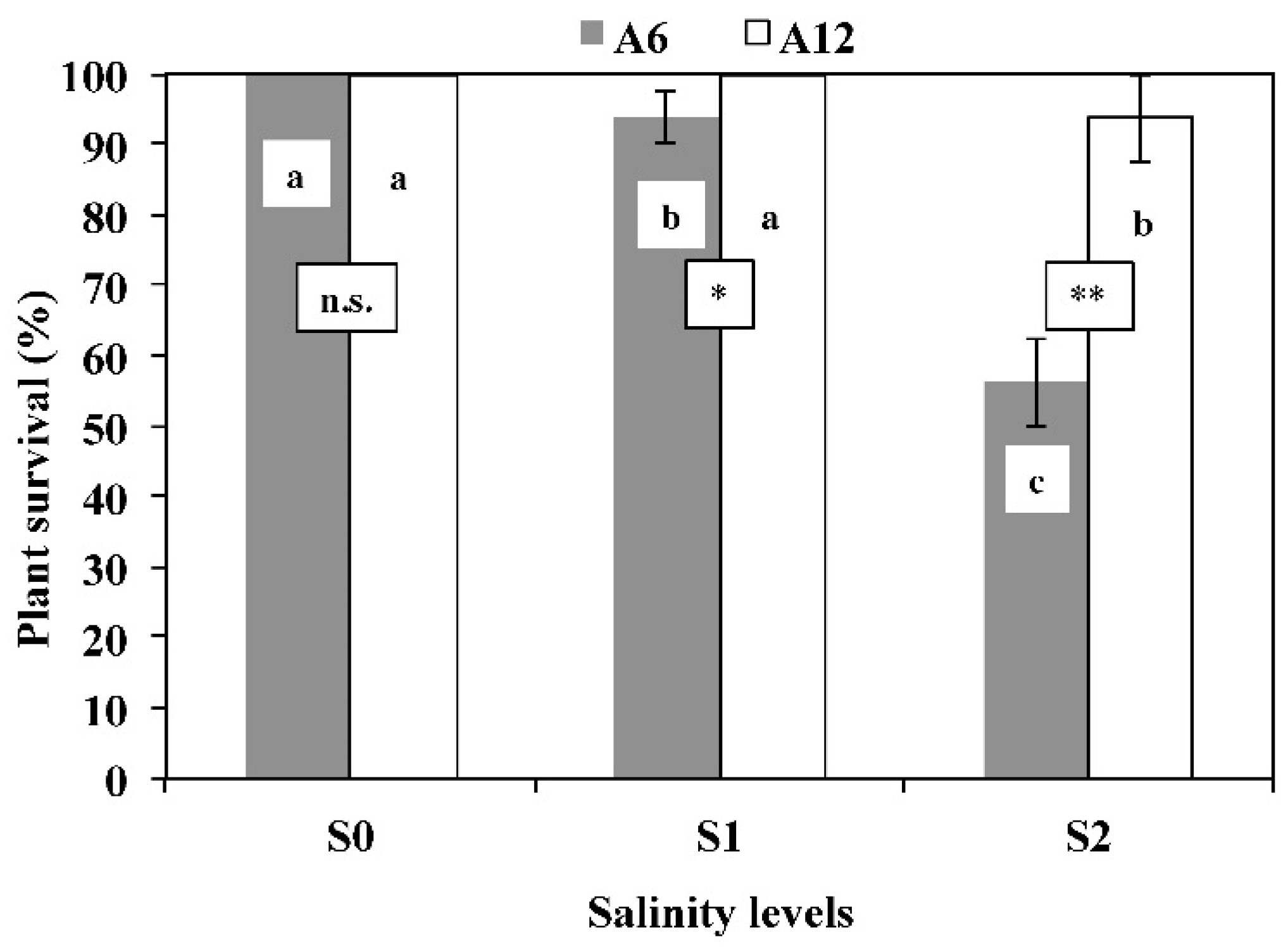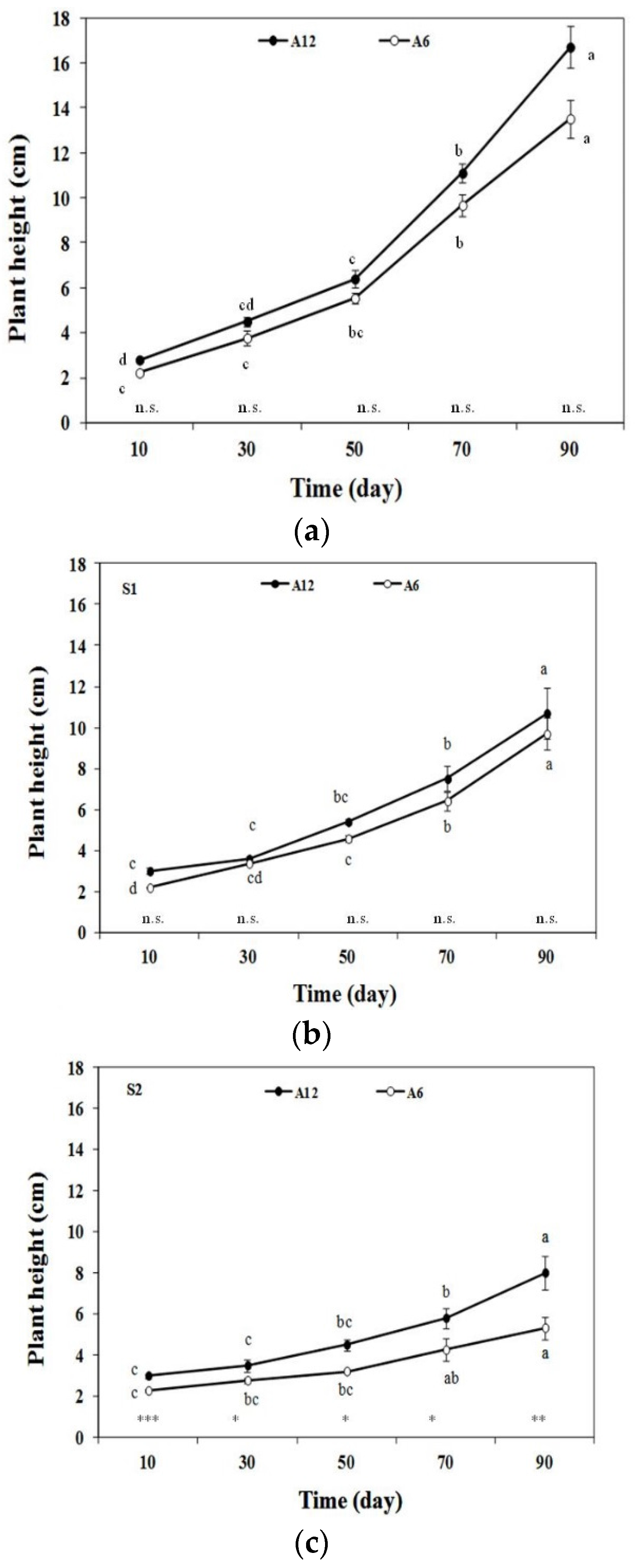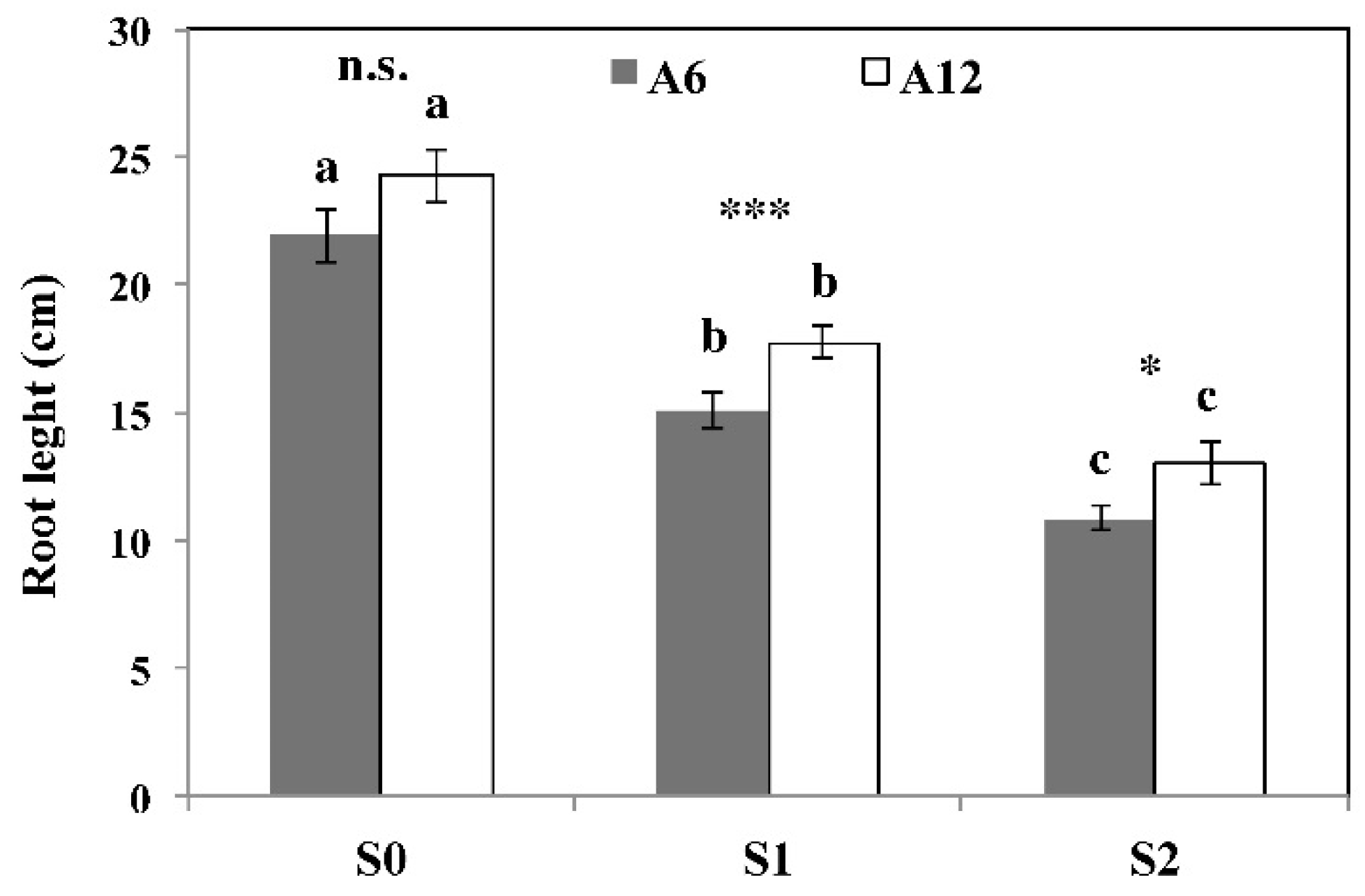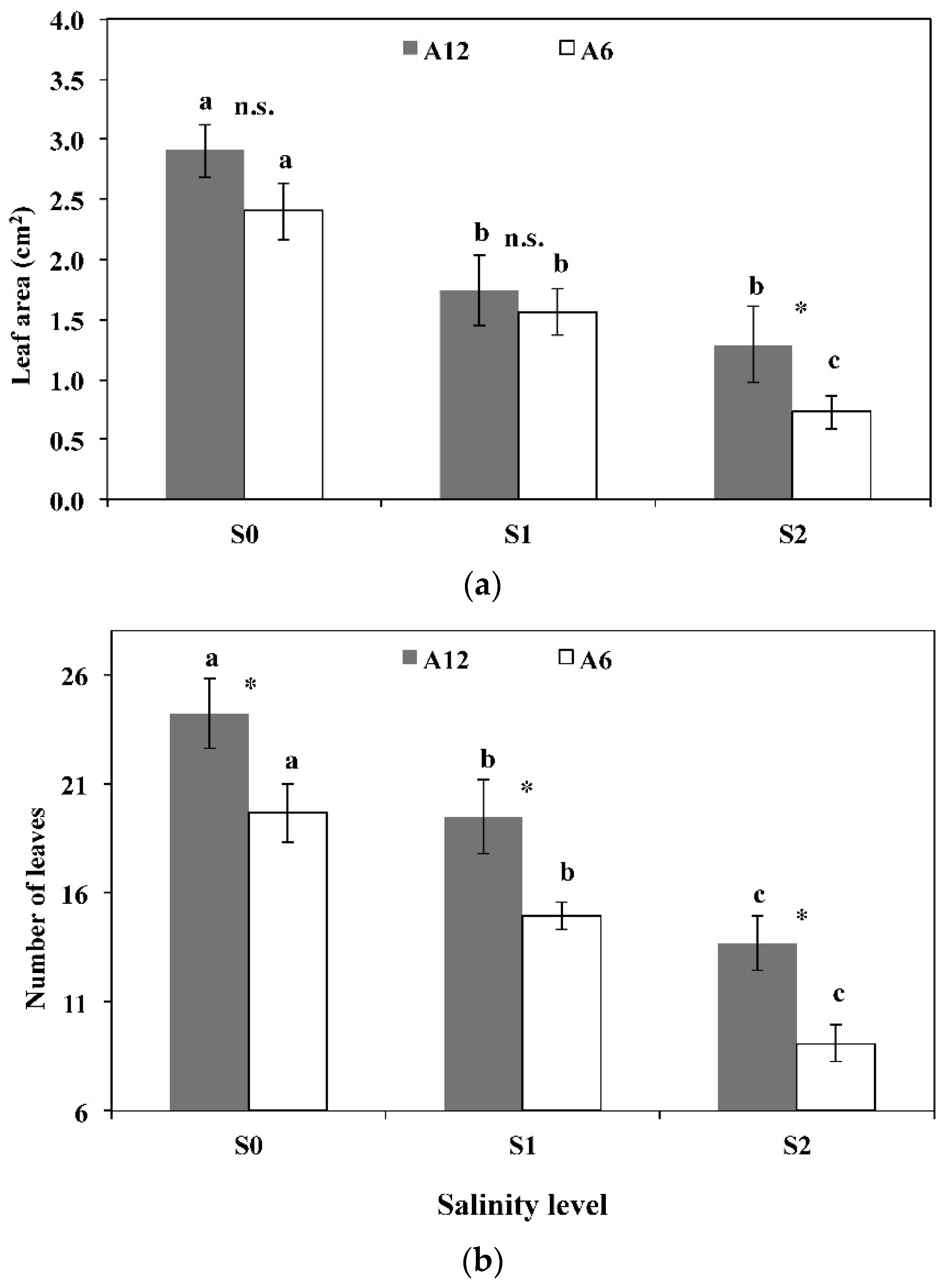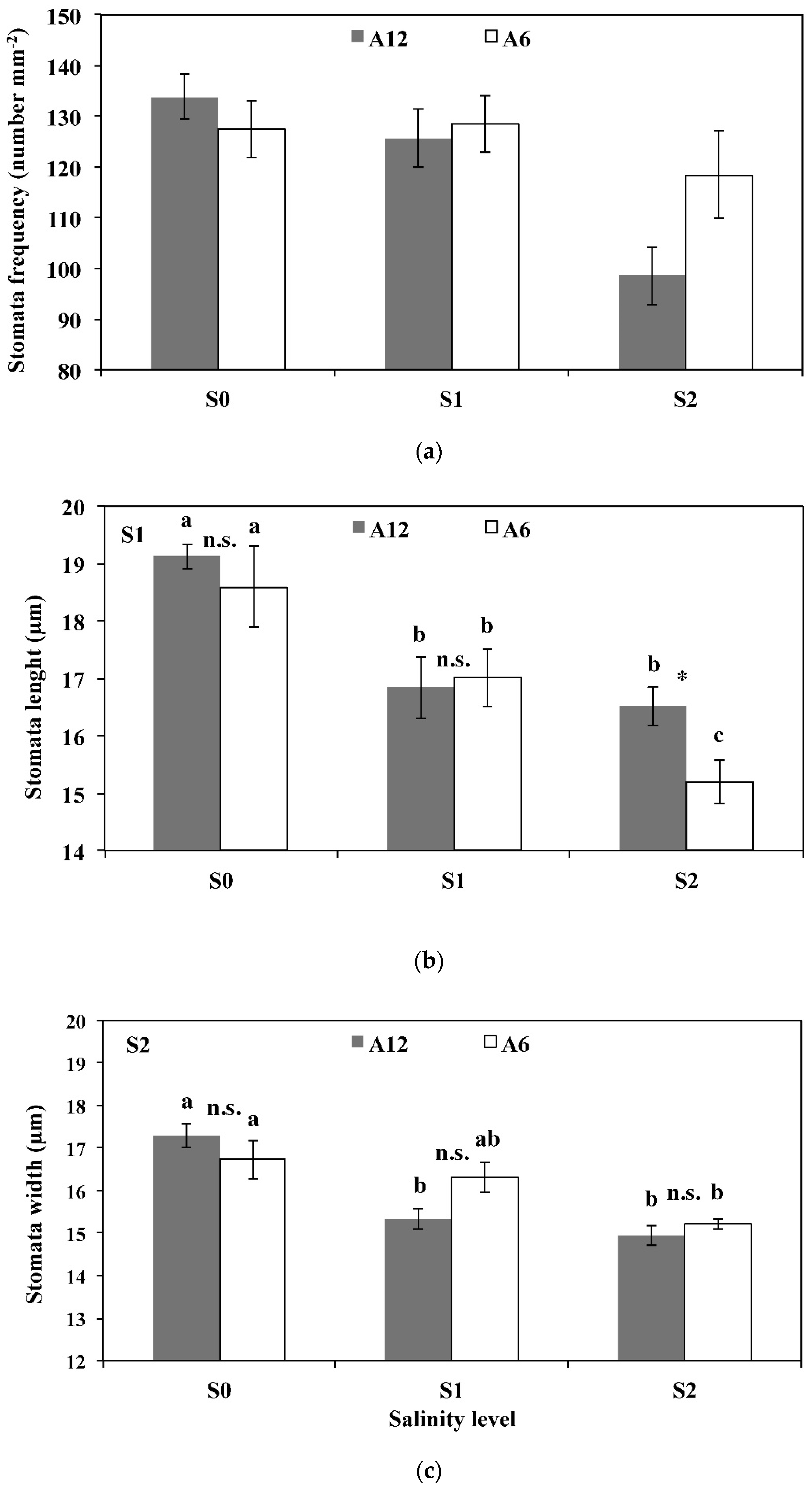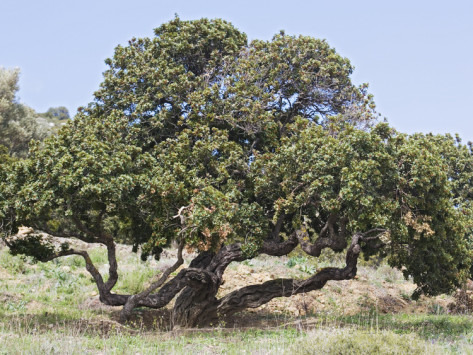1. Introduction
Pistacia lentiscus (Anacardiaceae) is an evergreen sclerophyll species, largely distributed in dry/warm areas of the Mediterranean basin and well-adapted to severe conditions of drought in very unfertile soils [
1,
2,
3]. In Southern Italy,
P. lentiscus grows in diverse habitats along a climatic gradient that varies in solar radiation, temperature, and precipitation. It is currently being investigated for its potential to restore vegetation in dry-land areas of the Mediterranean basin, which may suffer from excess soil salinity during the warm summer season [
4,
5]. This species (also named the mastic tree) is well known in Mediterranean countries for its resin—mastic gum—used since antiquity for incense, as a chewing gum for pleasant breath, for spicing liqueurs and jam, and in the cosmetic industry [
6].
P. lentiscus is a leading component of the low altitude Mediterranean maquis. Its distribution around the Mediterranean basin extends to north and eastern Africa and Madeira Island [
7].
Revegetation and afforestation programs for abandoned and degraded lands, encouraged recently by the EU [
8], frequently put pressure on nurseries for a massive young plant availability. Nursery production of native Mediterranean shrubs and trees in Southern Italy shifted from bare root plant production to container growing systems in the 1990s [
9,
10]. Currently, the choice of species in Mediterranean urban green spaces is oriented towards native plants, such as the mastic tree, that promote environmentally-sound landscaping practices [
11].
Salinity is one of the major abiotic stresses that affects plant production and growth in many arid and semi-arid areas [
12,
13]. Many semi-arid regions of the world are characterized by soil and water that are too saline, where net evaporation is high and soil washing results are negligible due to the limited freshwater associated with scarce rainfall and poor soil drainage [
14]. Salinity may affect ornamental shrubs by reducing growth and leaf expansion resulting from osmotic effects or toxicity due to the high concentration of Na
+ and Cl
− typical of saline water [
15]. However, to the best of our knowledge, there are few studies investigating the response of
P. lentiscus germplasm to saline stress in nursery production.
It was suggested that ecotypic differentiation has enabled
P. lentiscus to grow in different habitats [
16,
17]. The germplasm, therefore, allows us to assess the response of the species to different abiotic stresses. Thus, in the present study we evaluated the growing responses of two accessions of
P. lentiscus to three different levels of salinity under nursery conditions.
2. Materials and Methods
The research was conducted at the greenhouses of the Campus of the Department of Agro-Environmental and Territorial Science, University of Bari (Italy; latitude 41°06′ N; longitude 16°51′ E; 16 m a.s.l.). Previously, about 2 kg of fruits from two mastic tree accessions—labelled A6 (“Manfredonia”) and A12 (“Specchia”)—were collected from individual trees in the two different sites in the Apulia region (southern Italy), from the end of November to the beginning of December 2014.
Table 1 shows the main characteristics of the two sites. After harvesting, the fruits were stripped by manual squeezing using appropriate sieves and were perforated with jets of water for pulp removal.
The seeds were air-dried at ambient temperature, until the attainment of a moisture of ~6%–7%, and subsequently stored at 4 °C. The seeding was made using alveolate containers in a greenhouse. The production phase of the mastic tree plants ended two months after seeding, when the transplantation was performed in the same substrate subjected to three different salinity levels. The substrate for transplantation was a mixture (50:50
v/
v) of a ground air-dried soil and a commercial substrate for potting. The soil was a sandy-clay having total N of 1.6‰ and a field capacity and wilting point of 24.9% and 15.5% of dry weight, respectively. The commercial substrate had the following characteristics (on dry matter): 45% of organic carbon, 0.5% of organic N, 60% of organic matter, pH of 6, and electrical conductivity (EC
e) < 1.5 dS·m
−1. The mixture obtained had total N of 2.2‰ and a field capacity and wilting point of 35.6% and 22.5% of the dry weight, respectively. This mixture was subjected to three different levels of salinization (S0, S1, and S2) obtained by adding 0, 400, and 800 g of salts 100 L
−1 of substrate, respectively; the salts used were a mixture of NaCl and CaCl
2 in a weight ratio 1:1 (
Table 2).
Plastic pots (40 × 60 × 16 cm), having a hole necessary for the harvesting of the leaching fraction in a special bottle, were filled with the three substrates; subsequently, 20 plants for each accession were transplanted. A split plot experimental design was used with four replicates; the “salinity level” and “accession” were tested in the main plots and in the sub-plots, respectively.
Plants were grown under salinized substrates for 87 days: 72 days in the greenhouse and the last 15 days outdoors in order to allow an appropriate period of acclimatization of plants to direct sunlight, necessary for the measurement of leaf gas exchange. Irrigation was performed with water of good quality (ECw = 0.5 dS·m−1). The irrigations were performed manually distributing water on the soil surface when 35% of the available water was lost by evapotranspiration, as estimated by subsequent weightings. The volume of water for each irrigation was performed in order to limit percolation required to fully saturate the whole profile of substrate.
The following parameters were recorded: plant height (measured every 20 days); survival of plants and total root length; total biomass (on dry weight); number of leaves per plant and leaf area, measured using a leaf area meter (LI-COR 3100C, LI-COR, Inc., Lincoln, NE, USA) at the end of the trial.
Then, 60 leaves (10 leaves × 2 accessions × 3 treatments) were randomly collected to evaluate the stomatal characteristics, both frequency (stomata mm
−2) and size (width and length), following the technique reported by Camposeo et al. [
18] using light microscopy (Nikon Instruments Europe, Florence, Italy) and the image analysis software ARKON (version Arkon 32, Nikon Instruments, Florence, Italy). At the same time, on fully expanded, healthy, well light-exposed leaves [
19], stomatal conductance (mmol H
2O m
−2·s
−1), transpiration rate (T, mmol H
2O m
−2·s
−1; data not shown) and net assimilation rate (A, μmol CO
2 m
−2·s
−1) using the open system gas exchange analyzer LCA-4 (Leaf chamber Analyzer, ADC Ltd., Hoddeson, UK) with PLC (Parkinson Leaf chamber) B-002 (Analytical Development Company, Hoddesdon, Herts, UK), were determined under saturated photosynthetically active radiation (PAR > 1700 μmol m
−2·s
−1). Water use efficiency was then calculated as A/T (WUE, μmol CO
2 mmol·H
2O
−1). On the same leaves, midday leaf water potential (MPa) was measured according to Sholander et al. [
20]. For each treatment and for both accessions, all the ecophysiological parameters were performed on three leaves per plant.
Finally, on leaves, stems and roots, the contents of K+, Ca2+, Na+, and Mg2+ were determined using atomic absorption spectrophotometer (GBC 932 Plus, GBC Scientific Equipment Ltd., Dandenong, VIC, Australia) and total N by Kjeldahl method. These determinations were carried out on a sample comprising the biomass of both accessions, because the small amount of dry matter obtained for the higher salinity saline treatments did not allow us to obtain a sufficient amount of sample for analysis.
Data obtained were subjected, after angular transformation of the percentage values, to ANOVA according to a split-plot design; total N and cations plant content were analyzed according to randomized block design. The differences between means were evaluated with the Student-Newman-Keuls (SNK) test or using t-test when indicated.
4. Discussion
The findings of this research give useful information about the abilities of adaptation, survival, and growth of different accessions of mastic trees grown in nursery conditions under salt stress. The salinity level led to depressive effects on all examined parameters, such as the percentage of survival, the production parameters, the morphological parameters, and the physiological parameters. A different response to changes in salinity with respect to the above parameters was also recorded in the two accessions. These results confirm that salinity is one of the major environmental factors limiting the growth and productivity of plants, as already confirmed by available literature [
22,
23,
24,
25,
26,
27].
Regarding the ability of the plant to survive in a saline environment, the two accessions can be characterized according to the model proposed by Maas and Hoffman [
21], resulting in a high difference among studied accessions, as confirmed by the values of critical threshold, slope, and EC
es50%. Moreover, using the EC
es50% value,
P. lentiscus can be classified as “tolerant” to salinity in terms of relative survival during the early growing stage, as also reported by Tattini et al. [
2]. Furthermore, in the A12 accession, the high critical threshold value (17.23 dS·m
−1), very close to the maximum level of salinity used in this experiment, allowed the calculation of the slope value within a short residual range of salinity. Therefore, the real capacity of this accession to survive high levels of salinity could have been overestimated.
As expected, the salinity caused a significant reduction of both leaf area and number of leaves per plant. The same behaviour was observed for stomatal frequency and size. The values of stomatal frequency measured in this research resulted below the 325 stomata·mm
−2 observed in adult trees by Gratani and Varone [
28]. This result could be explained by the early age of the plants used in the experiment.
Leaf gas exchanges were hardly restricted when EC
e overcame 12.5 dS·m
−1; similar behaviour was reported for adult trees with reduction of stomatal conductance, net assimilation rate [
29,
30], and leaf water potential [
2]. As observed for stomatal parameters, ecophysiological data obtained were lower than those reported in the literature in the same plant species [
29]. Finally, no data are available in the literature regarding WUE. The physiological parameters indicated stress symptoms; nevertheless, accession A12 showed a more tolerant behaviour with respect to accession A6, with a better leaf water status value and higher values of leaf gas exchanges and WUE.
With respect to the total N content of biomass, a trend of higher values was observed with increasing salinity level, confirming the findings obtained by Seema and Habib-ur-Rehmam [
31] on
Panicum turgidum. According to these authors, the increase of the N content seen after increasing the salinity may denote a corresponding increase in the accumulation of protein. According to Zidan and Elewa [
32], salt stress can promote protein synthesis in plants through the transformation of free amino acids into protein. The salts containing sodium and calcium used for the different saline treatments determined an increase of these ions in all plant parts. The higher content of sodium found in the roots under the higher salt treatments, coupled with the largest contribution of the roots to the total biomass of the plant, could suggest a defence mechanism to sodium toxicity through the compartmentalization of this ion in roots, and its subsequent elimination through the radical turnover, determining the replacement of older (sodium saturated) roots with younger roots. This mechanism was previously observed in
Salvadora oleoides [
33]. The uptake of potassium and magnesium did not change based on the different levels of salinity, in agreement with the findings of other authors on different species [
12,
31,
34]. Moreover, the ability of the mastic tree to maintain an adequate selectivity in the uptake of potassium under a saline environment is often associated with salinity tolerance [
35].
